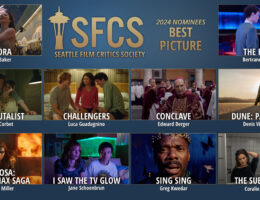We did it, folks. The movies are BACK! Box office numbers came in and last weekend’s accidental (but much capitalized-upon) “Barbenheimer” event set all kinds of records: Barbie brought in more than $356M and Oppenheimer collected an immodest $180M during their worldwide opening weekends, the biggest at the multiplex since the pandemic, which also set a revenue record for comedies as well as for Greta Gerwig as the biggest opening weekend for a female director.
Given the monumental event in summer blockbuster history, Chris and Josh collected ourselves and convened a quick roundtable to chat about our experiences with Christopher Nolan’s atomic age biopic and Greta Gerwig’s big budget fantasia about the original American Icon.
Let’s start with the practicalities: How did you see Barbie and Oppenheimer?
Chris: I saw Barbie at the Tuesday night at a preview screening, which was packed. There were a lot of people dressed up in pink, probably at least a quorum.
Josh: I had plans during the press/advance screenings; so I committed myself to the stunt of seeing both on the same day and snagged advance tickets: Oppenheimer at a near-sold out Boeing IMAX theater at Pacific Science Center; Barbie at a similarly packed multiplex setting at AMC Pacific Place. Both theaters faced popcorn shortages.
Chris: I didn’t notice any popcorn shortages as I probably ate yours and my bodyweight during the two-hour movie.
Josh: I started my Barbenheimer around 4 pm in Seattle Center after a matinee Mariners win against the Twins. I grabbed an expensive cocktail at the Chihuly bar to settle myself before heading in to the museum. The mood at Oppenheimer was anticipatory yet somber, Nolanheads fretting about finding the ideal view in one of the few remaining theaters without reserved seating. I spotted a few mid-century costumes: suits, ties, iconic hats.
Chris: For Oppenheimer, I saw it on an IMAX screen in Northgate. I thought 10:30 AM on Sunday would be the best chance I had for avoiding an enormous crowd. No such luck, the theater was nearly packed. The entire upper section was full so I was a lot closer than I wanted to be. Afterwards, the line for the men’s room was pretty massive, too.
Josh: I somehow beat the rush for Oppenheimer, largely by not reverently sitting through the credits and hopped on a LimeBike to Pacific Place (really should’ve mono-railed to get in the midcentury mood). Barbie crowds at the mall multiplex, unsurprisingly dominated the fashion game. Almost everyone I saw in the predominantly young female crowd was wearing some shade of pink (the best I could muster was a neon Mariners hat from last year). The packed theater lobby was giddy and chill, with the aforementioned popcorn crisis resulting in a long good natured queue for the machine to catch up with demand. It was quite honestly the most people, in the best moods, having the most fun time at a movie that I can ever remember encountering. In all my years of event moviegoing, I can’t think of anything that compares. Immaculate vibes, would highly recommend.
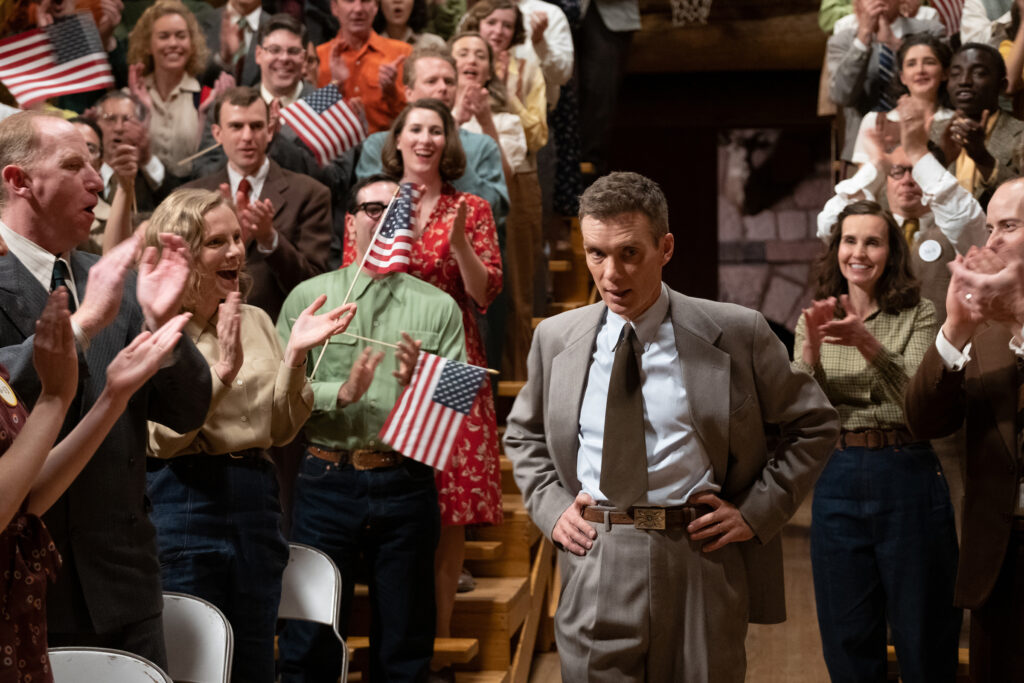
Let’s take the movies in historical order: Oppenheimer first.
Josh: Chris is writing a stand-alone review. So before we get into the highs and lows, I’ll try to get my overall thoughts on the film.
Although most of the Oppenheimer advertising focuses on the big boom of the bomb, Nolan splits the movie into two highly digressive halves. The first (“Fission”), in various color stocks and aspect ratios gets us into J. Robert Oppenheimer’s first-person perspective. Nolan structures the film around a stuffy 1984 adversarial administrative hearing over the matter of security clearances, convened to discredit Oppenheimer years after the great and terrible achievement that made him a household name. The conference room is small and bland and intended to be so dry that it barely merits attention, but as the parties negotiate the past, aggressively quick cuts and Cillian Murphy’s muted narration transports us through decades of the scientist’s past: studies in theoretical physics in Europe, a return to the States, and more pointedly, though, are the intertwined sexual dalliances and even more problematic flirtations with Communism. Amid “extended nudity” (a bedroom scene with Florence Pugh as Jean Tatlock might be Nolan’s first sex scene) this is the section that depicts the the creation and testing of the first atomic bomb with breakneck pacing of bringing disparate scientists (many among the Jewish diaspora) together, the years of sleepless coordinated scientific and practical work of the Manhattan Project in the manufactured New Mexico desert town.
The horrible depiction of the “I am become death” explosion is the closest Nolan comes to staging an action setpiece, but the fireworks themselves are almost a sidenote to an very talky movie whose primary effects are faces and conversations. We don’t see Hiroshima or Nagasaki, but grounding the film in Oppenheimer’s perceptions and watching Murphy face an uproarious celebration upon the success of the bomb is possibly even more effective than a grotesque reenactment of seeing the destruction of the cities and people whose targets were determined in clinical administrative planning sessions.
The second (“Fusion”), set five years later, is filmed in black & white. Playing like a cloistered political drama, it centers around a 1959 Senate confirmation hearing for Lewis Strauss (Robert Downey Jr., disappearing into a role that’ll certainly snag him awards nominations), a onetime Oppenheimer advocate at Princeton and sparring-partner on the Atomic Energy Commission who yearns to be Eisenhower’s Commerce Secretary. Unspoken issues with his previous affiliations with Oppenheimer haunt the proceedings, and Nolan induces a sense of mystery and simmering drama by keeping the specifics of a scientist’s tarnished reputation unspoken as long as possible. These might be described as two halves, but they cross cut between each other, and each have flashbacks within flashbacks. It makes the structure of this summer’s other atomic age drama Asteroid City seem quaint, but like Anderson’s opus, it is also a broad stage for a cavalcade of beloved character actors to shine in brief appearances. There are so many “that guy” appearances, it’s hard to catch your breath as they rocket through the proceedings, cross-cut across time periods, and leave us to untangle dueling motivations.
Still, even at the end of this biopic the subject himself is – despite three hours of near-constant screen time and an outstandingly haunted performance by Cillian Murphy – something of an enigma. That’s not a flaw of the film or by any means an accident. Unlike many other “great mind” biopics, Nolan avoids the embarrassing trap of “great scientist having great big thoughts” and instead employs cutaways to experimental filmmaking with sparks representing the turbulent subatomic realm and allowing reality to occasionally ripple to put us into Oppeheimer’s brilliant but troubled mind. Instead, like the project to harness the power of the atom, ostensibly to end a war – or at least to get ahead of the Germans (and then the Soviets) – much of the storytelling is grounded in pragmatics of scientific progress rather than the lofty equations that underlie them.
In this context, Oppenheimer is often depicted as what he needs to be for a particular moment or for a particular audience and we watch Murphy depict the necessary chameleonic adaptation depending on his audience. A brilliant theoretician, a compelling marketer, an Jewish-American outsider perpetually demonstrating loyalty to his country, a taskmaster of people in a race against anti-semitic fascists, and ultimately the face of an awful creation that ended a war and transformed the world (for worse and better). It’s a heavy mantle and Murphy bears it well. He conveys the sickening realization of what years of relentless, around-the-clock, work and scientific breakthroughs have accomplished as he faces the foot-stomping applause on the day that their creation made its debut on the world stage yet also shoulders the contradiction of nevertheless being convinced that the weapons would forever end war. It’s thus, a dual, slow moving tragedy, as we come to understand the isolation of a figure who Nolan’s called “the most important person in the world” discovering how easily he can be set aside when he stops being useful to the real power brokers. Nolan leaves us with that sobering feeling and the emptiness hits like a bomb.
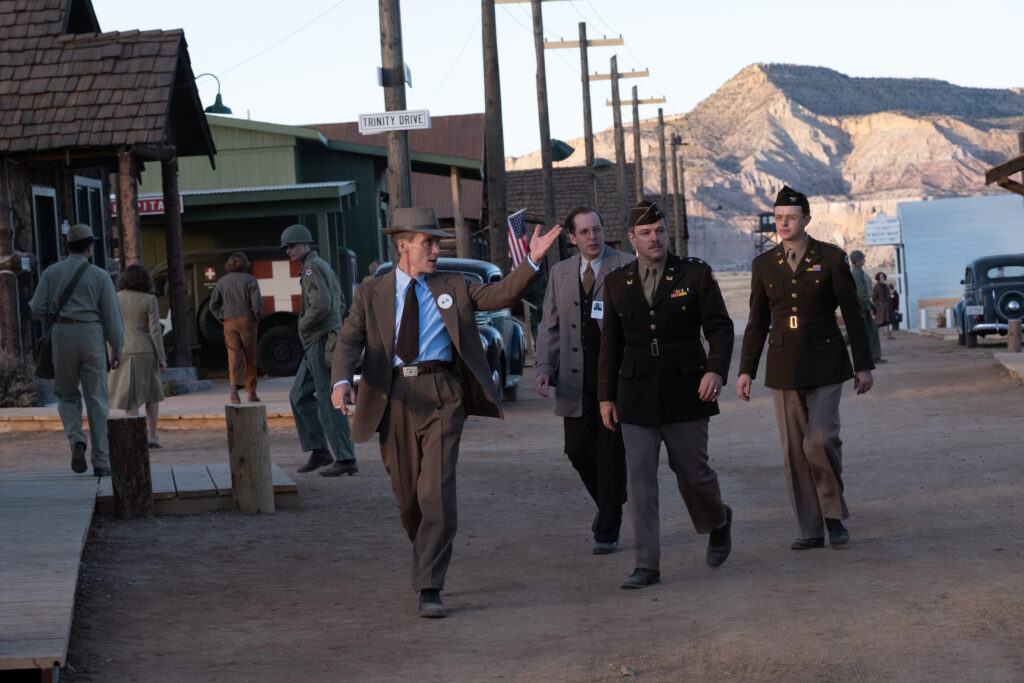
Oppy Chat: Overall Reactions
Chris: Josh, I think I liked Oppenheimer a bit more than you did just because I exited the theater blown away and convinced this might be one of the best movies I’ve ever seen. It might seem a bit hyperbolic in the very near future but I’m still carrying that buzz as I’m writing this.
Josh: A friend asked me whether this was Nolan’s “magnum opus” as we were exiting the theater. With my thoughts still unformed, my immediate reaction was that Oppenheimer was very good, but Dunkirk remains Nolan’s only perfect film. They’re an interesting pairing: both set in World War II, one about so-called ordinary citizens working to keeping the war effort alive, the latest about extraordinary minds coming together to create a weapon so awful it would end it. I do think that this is near the top of his filmography, which I generally enjoy in spite of some flaws and tics.
Chris: I don’t consider myself a Nolanhead (I’m not completely certain I’ve even seen the entire Dark Knight trilogy) but nearly everything here worked for me.
Josh: I do appreciate how it’s less about the specifics of unleashing the deadly infinite power of the atom than a biopic grounded in the ability of old Jewish men to hold extremely long grudges and enact revenge over modest slights. It’s very welcome that the human element was so central to this big story.
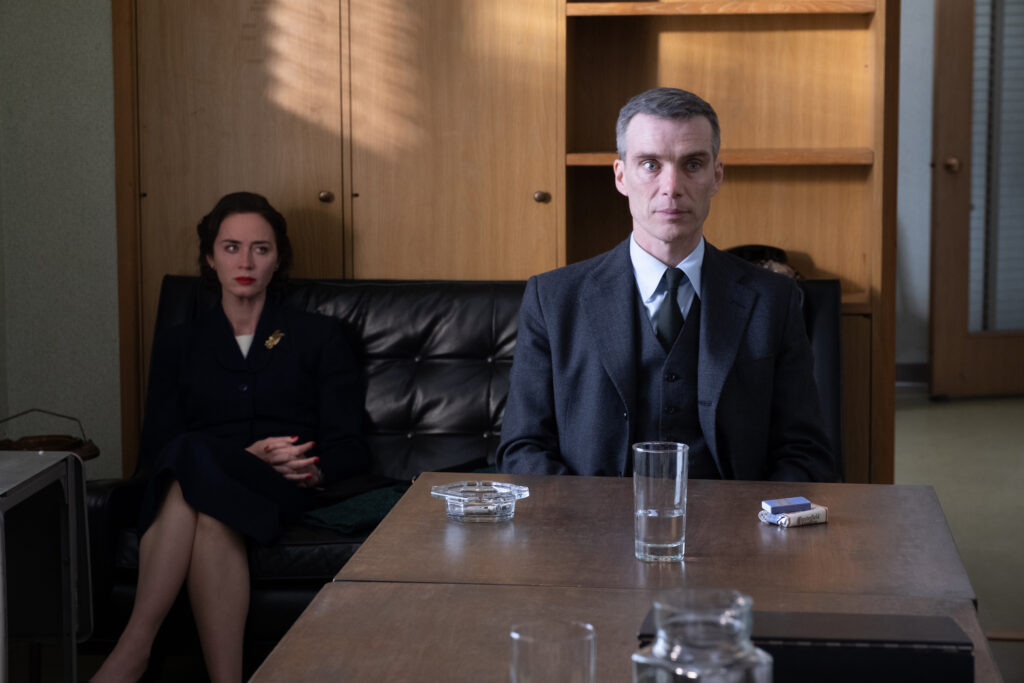
Oppenheimer: What hit?
Chris: I had some apprehensions going in that this might be a hagiography of someone credited with the creation of the most dangerous weapon ever built, and there was a lot of that, but I thought the exploration of the moral and philosophical arguments were one of the factors that held the movie together. I also completely agree with you about the power of Oppenheimer’s speech and the uproarious reception after Hiroshima and Nagasaki.
Josh The IMAX cameras do their wonders on landscapes, haunted faces, and claustrophobic rooms. It’s vivid and fully immersive, a master achievement from Hoyte Van Hoytema using all the tricks in his massive toolkit. While you might not get exactly the same effect without seeing three hours of Cillian Murphy’s crystal blue eyes projected as large as planets, the most compelling reason to see Oppenheimer in the biggest, best, theater you can find may be the sound design and Ludwig Göransson’s monumental score.
Amid the breakneck cuts between time periods and plotlines, I may have occasionally lost the exact threads, but the immense soundscape penetrated and propelled the overall mood to make the film a success.
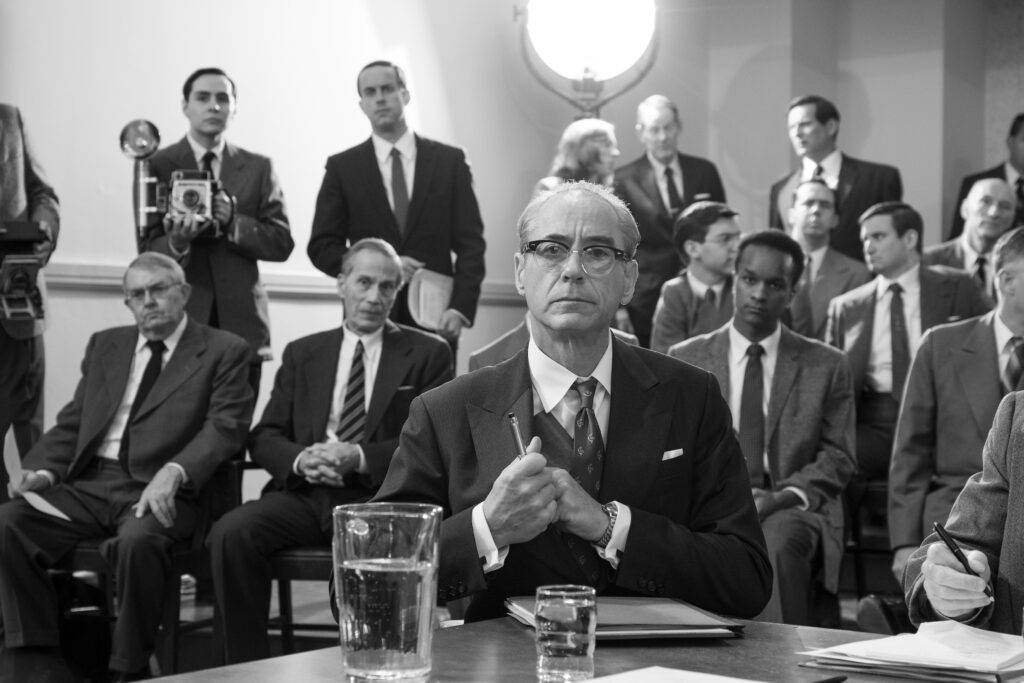
Oppenheimer: What missed?
Josh: History is what it is, but Nolan’s perpetual sidelining of women plagues this film, too.
Chris: I agree with you about the sidelining of women, though I thought Emily Blunt’s performance as Kitty Oppenheimer was one of the most powerful in the movie. Each scene she’s in, she provides an emotional weight that Cillian Murphy’s Oppenheimer needed.
Josh: I agree, I kept wondering what Emily Blunt was doing in this movie and was thrilled when she finally got her moment.
Chris: I don’t think Florence Pugh was used as effectively as Jean Tatlock, an ex-fiance with Communist ties that Oppenheimer can’t completely divorce himself from despite the danger she poses to his career.
Josh: If I’m picking any nits, I’d say that on first viewing I was less confident about the success of the second section. It’s fun to see RDJ and Alden Eherenreich navigate the structures of power of Senate procedure to enact their own agendas. The manufactured mystery and the way the plot folds back and forth on itself creates a sense of propulsion, discovery, and a satisfying denouement. But I might need to watch it again to understand if the ends justify the means (and extra hour of running time).
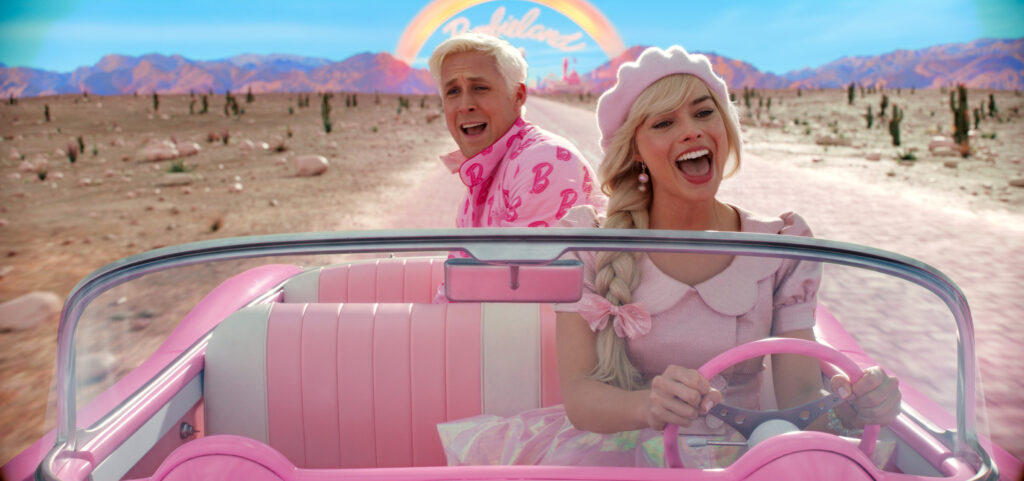
On to Barbie, let’s go party.
Josh: Again, you’ve got the stand-alone review of Barbie for the site; so I’ll try to summarize my reaction before we get into our highs and lows.
From its opening segments, complete with original music and brilliantly choreographed dance sequences, something feels off in the uncanny valley simulacra of girl power utopia of Barbieland. Greta Gerwig immerses us in this world with incredible practical sets and costume design, and the execution of them convey an inherently offbeat uncanny valley of Stepford Barbies ruling a picture perfect world in perfect upbeat harmony. You don’t have to be a perpetually cast-aside Ken to find the setting and its coordinated dance numbers just a little bit creepy.
At the center of this world, Margot Robbie’s portrayal of “Stereotypical Barbie” amid a star-studded cast of other more traditionally “accomplished” Barbies (Doctor, President, Supreme Court, President, Nobel Prize, etc.) is impeccable. Robbie being a producer of the film somehow makes this extra entertaining. As her permanently upbeat facade cracks with confusing intrusive thoughts of death she takes unwelcome side effects like a tiny patch of cellulite in malfunctioning flat-footed stride. We see the panic setting in as stereotypical perfection slips through her grasp, but she nevertheless remains undaunted when she accepts an impossible mission from Kate McKinnon’s hilarious Weird Barbie to venture into a barely-understood Real World.
Gerwig’s uses Mattel’s vast IP toybox as a construction set for a supremely modern mashup that plays with ideas as old as the Wizard of Oz or as thorny as the Matrix (with a Kubrick parody as opening scene), that’s extremely pop, relentlessly funny, and vibrantly realized. When Barbie, and tag-along Ken (a supremely rich performance by Ryan Gosling), cross into Los Angeles in search of the human person whose thoughts have caused her crisis of bubbliness, she also confronts the flawed ideas underlying the only idyllic feminist utopia she’s ever known. With the world of humans depicted in broad comedic strokes, the transition is as jarring for the audience as it is for Barbie.
There, Barbie encounters the executives that created her, unexpectedly crass treatment of women, the harsh reality of having to pay for cute outfits, and America Ferrara and Ariana Greenblatt as a sweetly realized mother and surly teen daughter whose fraying relationship has been inadvertently pulling her strings. For his part, Ken discovers the comforting embrace of the patriarchy, the alien power of horses, and brings these toxic ideas back to turn Barbieland into a Kendom.
The paired crisis of fleeing a gaggle of cartoonish corporate profit-mongers who want to put her back in her box and restoring her dream world from one where women exist to serve the needs of freshly empowered Kens makes for a hilarious setting for laugh-out-loud gags and setpieces. Like Barbie’s Dream House, it’s also a safe stage for confronting big existential questions through play.
It’s sentimental without falling into afterschool specials and takes itself seriously while still having fun. It’s very easy to imagine something in this absurdist mold having being accomplished instead with animation or CGI with A-list stars putting in a few days worth of voice work. Instead, Gerwig realizes it with real actors, outstanding commitment to its many very funny bits, fantastic musical numbers (original and deeply millennial needle drops, one of which is possibly the funniest joke of the whole thing, if not the year), with eye-popping practical set design that embraces the contours of unreality or a world constructed entirely from toys. It’s both fantastical and lived-in, with Margot Robbie and Ryan Gosling again proving that in addition to being among the most attractive humans on earth, they’re also unfairly gifted with adept comedic timing.
Gerwig and her deep and incredibly talented cast infuse the film with an earnest direct feminism that’s will be criticized for its simplicity as well as enflaming certain quarters to accuse Warner Bros of unleashing the Great Woke Satan on our nation’s innocent children. To me, this felt exactly right, conveying an awareness of both the breadth of the audience and the impossibility of resolving every conflict inherent in the modern discourse. It doesn’t necessarily “solve” anything. That’s not its burden. Instead it’s a regularly joyous romp that leaves its audience both satisfied, seen, and possibly transformed.
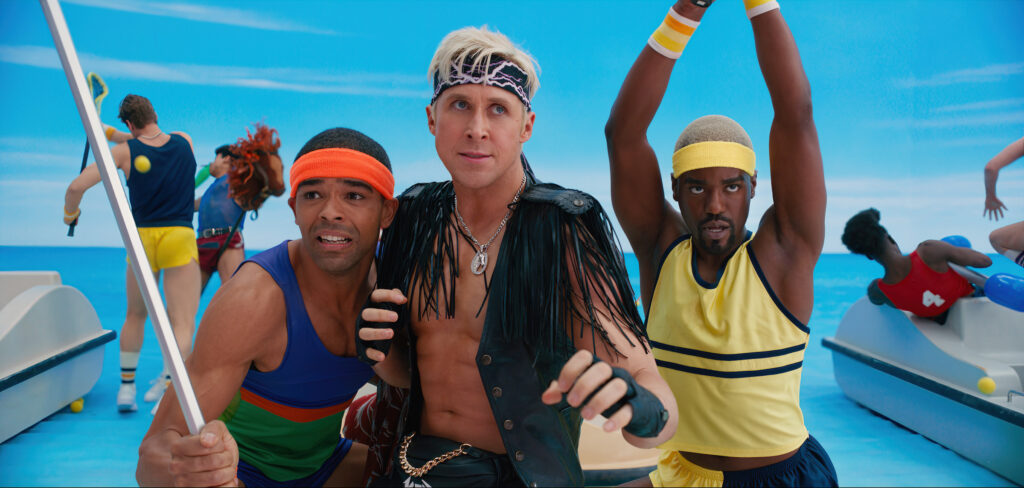
Reactions to Barbie
Josh: My immediate reaction was that Barbie was a half-star better than Oppenheimer, but that’s subject to historical re-evaluation and may be related to my experience of the day. I found myself in complete disbelief as the film moved through its different acts, mainly because it has the broad structure of an unhinged children’s fairy tale with all the self-referentiality of the Extremely Online. This is a supremely weird movie and I loved it.
Chris: I liked Barbie quite a bit too, though I think I’m more bullish on Oppenheimer than you were and more bearish on Barbie. It was a weird movie with a lot that really, really worked for me.
Josh: I feel like there was an incredible degree of, let’s call it “suspicion” or “apprehension” about a beloved “indie” director getting drawn into the muck of commercial filmmaking. Which, I guess is something, but to me feels like a weird combination of outmoded thinking and lack of trust in a reliably great director to make good choices.

If nothing else, it is a phenomenal use of huge piles of corporate dollars by a total weirdo. (I keep thinking about how Gerwig and Baumbach collectively spent nearly a quarter billion dollars making Barbie and White Noise and releasing them within the span of one year. It’s an epic use of gigantic piles of corporate money and I’m here for it.)
In terms of commercialism, my overall thought was that I’m not sure if this makes kids want to play with Barbies. It didn’t make me want to buy a bunch of dolls for my niece. But just when you think you’re immune to a covert sales pitch, I’ll be damned it if I didn’t buy an article of clothing featured in the movie within 24 hours of seeing it. The only reason I waited that long is that the website selling it seemingly hadn’t been launched when I was walking home from the theater at 11 pm on a Thursday night. I consider it a failure of capitalism that pop-up stores weren’t available outside the lobby.
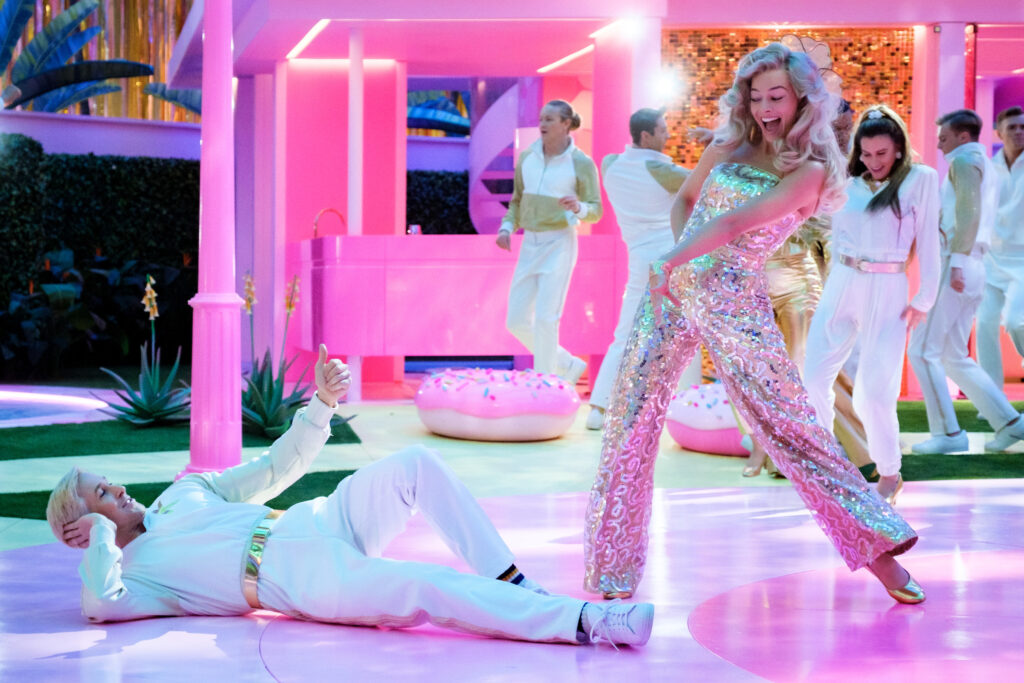
Barbie: What hit?
Chris: My favorite part of Barbie was Barbieland, which is just wondrous. There was so much attention to detail in creating a pink utopia. The world-building is simply phenomenal.
Josh: I am sure that someone else could’ve been cast in this role, but it’s hard to imagine anyone better for it than Margot Robbie. She’s both in on the jokes and has the presence to make the emotional beats work. It’s no easy task when much of the role calls for her to have the necessarily limited emotional range of a perpetually upbeat plastic doll. It’s a marvel how she moves these slowly emerging realizations to the surface and does so without needing to visibly swing for the fences [e.g., her bonkers performance in Babylon]. There’s a ton of this performance that’s internal, which doesn’t always get recognized, particularly in comedy.
The same could (and should) be said about Ryan Gosling and his portrayal of the pathos of Ken, a character who’s basically among Barbie’s least fun accessories. She’s doing it backwards in heels, he’s doing it with sweet broad naivety in roller blades. It’s a dynamite combo.
Chris: Completely agree with what you said about Margot Robbie. She’s a great and versatile actress and has so far been incredibly deft at choosing the right projects.
Josh: It’s also pretty obviously a movie that doesn’t work (in this form) without Greta Gerwig, who brings a great deal of care and consideration to every element of the film: writing, concept, casting, execution. As with all her films, you can feel her presence throughout. The monologues are very much in her voice, and there’s a pervasive sense that she wants to do right by everyone in it and everyone seeing it, which creates a rare feeling of comfort, safety, and discovery. And that culminates to unlock something for the audience, somehow, to know that they are being taken seriously even amid all the frivolity and fun.
Chris: This might be my fourth favorite Greta Gerwig movie but you’re right, of course. The care put into every facet of the filmmaking process showed up in the final product.
Josh: Oh, don’t make me rank her movies. Lady Bird and Little Women are all-timers. I don’t know if Barbie tops them for me, but I celebrate its wide-reaching appeal and what it might unlock for her as a filmmaker and for its vast audience as future film-goers. Sean T. Collins has a great piece on how Barbie is in the great tradition of films like Ghostbusters and Gremlins: barely kid-friendly films that unlock glimpses of the adult world to young viewers. Barbie as a live action movie for adults that kids can watch is such a welcome corrective to so many years of live action movies for kids that so many adults treat as prestige drama. I hope it’s a little swing in that pendulum.

Barbie: What missed?
Josh: I really loved the film, but there’s a whole section of the film that brings the characters into “the real world” that’s also presented as a broad cartoonish satire. I get it, but also could have done without the Mattel boardroom as inept Barbie-hunters subplot. There are some good jokes, but you can feel the movie kind of giving up on it and sidelining that thread once it realizes that the conflict of overthrowing the excesses of Kendom by “re-wokening” Barbies is far more compelling.
Chris: I also agree with what you said about the inept suits and agree that I’m glad they didn’t play a bigger factor in the second half. I did think Will Ferrell was extremely funny and his line “We’ve got gender-neutral bathrooms up the wazoo” was what made me laugh the hardest. But a little Will Ferrell goes a long way, so I didn’t need his part to be any bigger.
Josh: I know you bumped up against some of the explicit cringe-factor in these part and can see where you’re coming from. But to me, this at least fit with the overall mode of the film while the inept suits felt like a step too far.
Chris: Yeah, that’s probably right with how I felt. I was trying hard to avoid echoing the rightwing talking points because the backlash was so incredibly stupid, but I’m not sure I succeeded in my review. I really appreciated how weird the movie was. I think I’ve been in recovery for being Extremely Online for quite a while now, so I find a lot of online discourse to be cringey. Still, that is my problem, not anyone else’s.
The second hardest I laughed was when Ken kept repeating the name of his new abode which included way more synonyms for “home” than necessary.
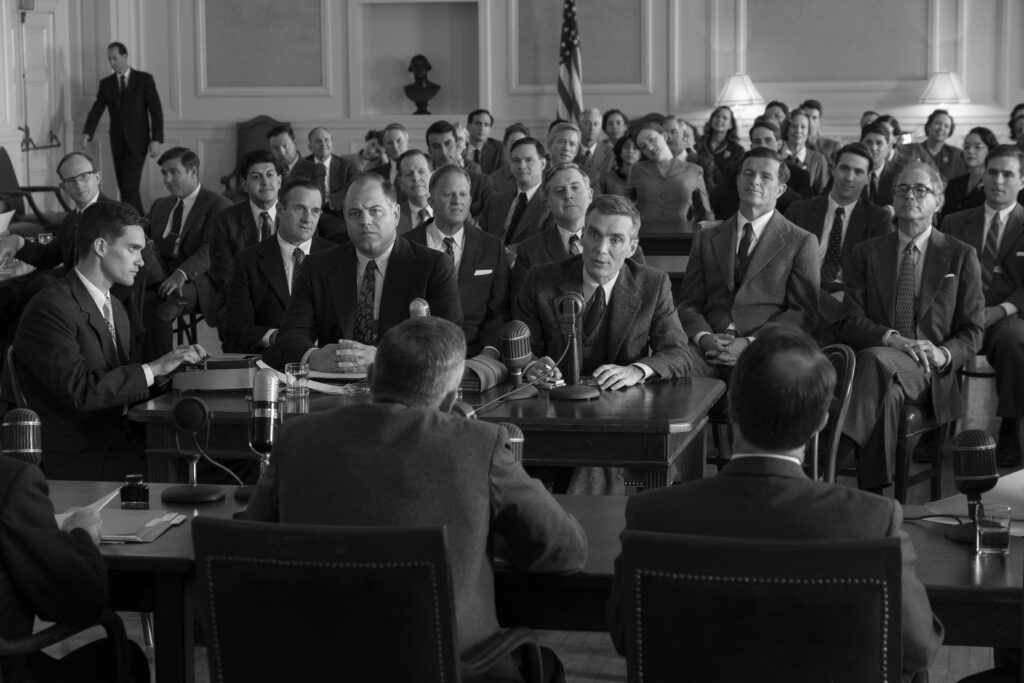
Answering the tough questions: should they be seen on the same day? In which order?
Josh: I enjoyed my own journey of doing the same-day double feature, but don’t think it’s absolutely necessary. If you’re going to see both on the same day, I’d strongly advise Oppenheimer first, Barbie second. It gives you a fresh slate to absorb the heavy themes of the atomic age followed by the sparkly chaser of a comedy that lets you end the evening on an upbeat note.
However, if you haven’t already seen them and are doing different days, I insist that you see Barbie as soon as possible. The ebullient reaction from a full theater can’t be replicated at home. I’ve probably said it before, but there is no special effect as powerful as a crowd collectively sharing a laugh, a cry, or a great time. I wish more studios (and/or audiences) would remember this when deciding release strategies, but don’t miss the chance to ride the choppy wave of Barbie-mania.
Chris: I’m not sure I would’ve been able to watch both on the same day, and I have much respect for you being able to do that. Driving to and from Northgate from Lower Queen Anne took about five hours out of my Sunday. Barbie definitely needs to be seen in a full theater but I would’ve appreciated a little more breathing room (and maybe an aisle seat) during the three-hour Oppenheimer.
Having said that, I’d see Oppenheimer first because having a Barbie palette cleanser would be a hedge against having nightmares of nuclear war.
Josh: I’m probably going to break my own advice with a re-watch. From our conversation and now that I know what I’m in for, I think that when I do a second viewing (maybe checking out the 70mm print) I owe it to myself to let Oppenheimer sink in rather than be chased with Barbie bubbles.
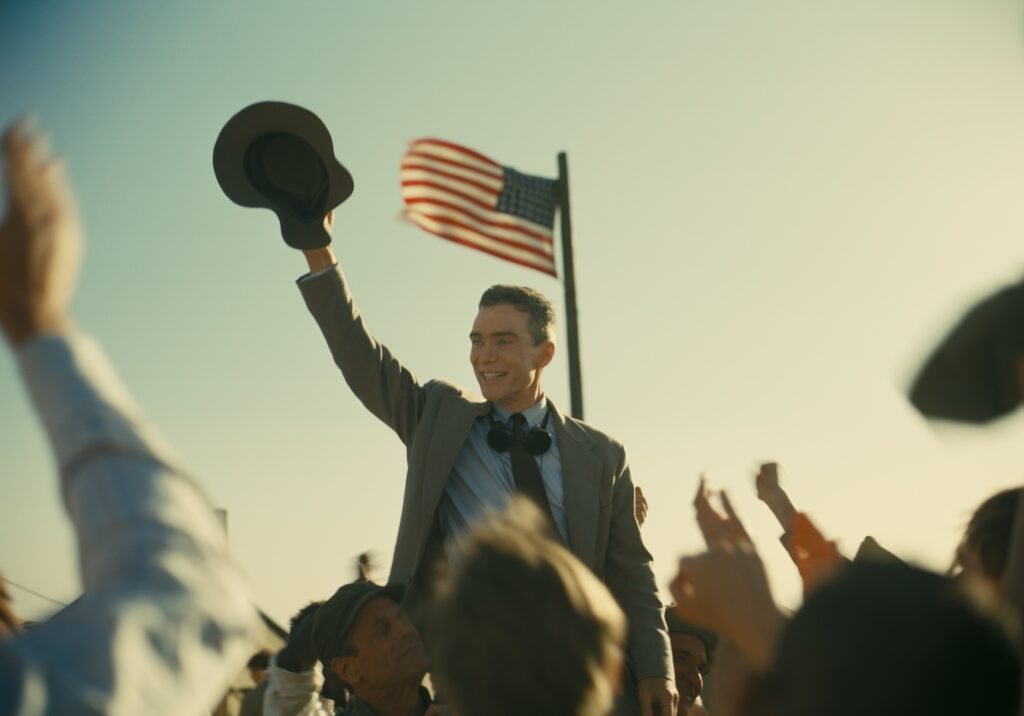
Are there inadvertent similarities between these seemingly very different movies? Or does it just feel that way through the coincidence of studios warring over the summer calendar?
Josh: Gerwig’s recent movies are all concerned with self-authorship and identity creation and Nolan, too, frames Oppenheimer less in the muddled quantum realm of ideas and theory than in the pragmatic world of practicalities and perception. While Barbie’s primary conflict is her self-actualization, Oppenheimer must become more brand than a scientist to accomplish his goals. In both cases, when the protagonist stops working to serve the desires of its corporate or government masters, the structures of power constrict to put each back in their box (literally a box in Barbie; a small room in Oppenheimer).
Chris: The US bombed Hiroshima and Nagasaki in 1945, and the first Barbie doll was released in 1959, so both were clearly part of the baby boom generation, so the nostalgia they inspire aren’t from completely disparate eras. I hadn’t thought of Oppenheimer becoming a brand after the success of the Manhattan Project but you’re completely right. He was using his name and reputation to influence policy.

Are the movies “back”? Is this a one-off phenomenon of people being excited to go to the theaters?
Josh: … I really hope so. Movies are so much more fun when everyone’s seeing them and we have some common things to talk about!
Chris: I certainly hope so too! I think with the strength of these two films, and the Mission: Impossible movie that opened last weekend, I think there’s some great offerings. I suppose it’ll live or die by the strength of the movies, but right now, there’s a lot of reasons to be optimistic in the long term and excited to go to the theater in the immediate future.
Josh: With the ongoing strikes, there’s talk that studios will postpone releases since so much of the launch strategy relies on the talent to raise awareness of the films. There’s perhaps no better case for this than Barbie and Oppenheimer’s casts organically turning what could’ve been a cutthroat competitive weekend into a series of feel-good viral posts of supporting each other. It encouraged moviegoers to do the same and paid off supremely at the box office. Still, the thought of studios holding movies hostage and stalling what’s been a very perilous post-pandemic road back to theatrical distribution strikes me as exactly the kind of self-inflicted wound that we really don’t need right now.
All images courtesy Universal Pictures (Oppenheimer) and Warner Bros. (Barbie). Both films are playing everywhere, and in Oppenheimer’s case, in multiple formats. AMC Pacific Place has the coveted 70mm film presentation; Pacific Science Center has “true” IMAX (lasers).
This piece was written during the 2023 SAG-AFTRA strike. Without the labor of the actors currently on strike, the film being covered here wouldn’t exist. More information about the strikes can be found on the SAG-AFTRA Strike hubs. Donations to support striking workers can be made at the Entertainment Community Fund.

